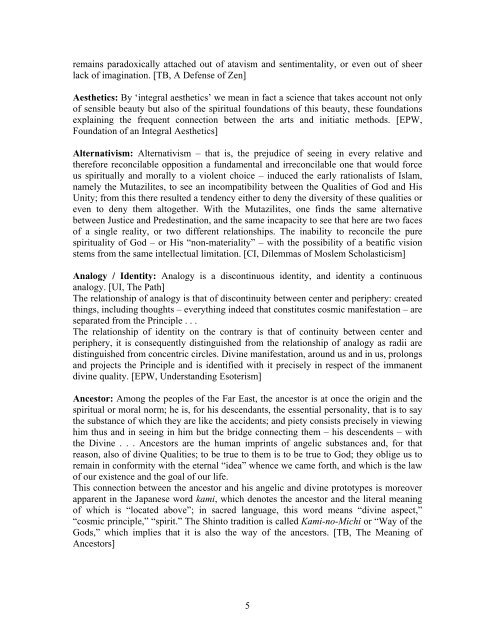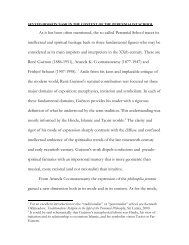glossary of terms used by frithjof schuon - Sophia Perennis
glossary of terms used by frithjof schuon - Sophia Perennis
glossary of terms used by frithjof schuon - Sophia Perennis
Create successful ePaper yourself
Turn your PDF publications into a flip-book with our unique Google optimized e-Paper software.
emains paradoxically attached out <strong>of</strong> atavism and sentimentality, or even out <strong>of</strong> sheer<br />
lack <strong>of</strong> imagination. [TB, A Defense <strong>of</strong> Zen]<br />
Aesthetics: By ‘integral aesthetics’ we mean in fact a science that takes account not only<br />
<strong>of</strong> sensible beauty but also <strong>of</strong> the spiritual foundations <strong>of</strong> this beauty, these foundations<br />
explaining the frequent connection between the arts and initiatic methods. [EPW,<br />
Foundation <strong>of</strong> an Integral Aesthetics]<br />
Alternativism: Alternativism – that is, the prejudice <strong>of</strong> seeing in every relative and<br />
therefore reconcilable opposition a fundamental and irreconcilable one that would force<br />
us spiritually and morally to a violent choice – induced the early rationalists <strong>of</strong> Islam,<br />
namely the Mutazilites, to see an incompatibility between the Qualities <strong>of</strong> God and His<br />
Unity; from this there resulted a tendency either to deny the diversity <strong>of</strong> these qualities or<br />
even to deny them altogether. With the Mutazilites, one finds the same alternative<br />
between Justice and Predestination, and the same incapacity to see that here are two faces<br />
<strong>of</strong> a single reality, or two different relationships. The inability to reconcile the pure<br />
spirituality <strong>of</strong> God – or His “non-materiality” – with the possibility <strong>of</strong> a beatific vision<br />
stems from the same intellectual limitation. [CI, Dilemmas <strong>of</strong> Moslem Scholasticism]<br />
Analogy / Identity: Analogy is a discontinuous identity, and identity a continuous<br />
analogy. [UI, The Path]<br />
The relationship <strong>of</strong> analogy is that <strong>of</strong> discontinuity between center and periphery: created<br />
things, including thoughts – everything indeed that constitutes cosmic manifestation – are<br />
separated from the Principle . . .<br />
The relationship <strong>of</strong> identity on the contrary is that <strong>of</strong> continuity between center and<br />
periphery, it is consequently distinguished from the relationship <strong>of</strong> analogy as radii are<br />
distinguished from concentric circles. Divine manifestation, around us and in us, prolongs<br />
and projects the Principle and is identified with it precisely in respect <strong>of</strong> the immanent<br />
divine quality. [EPW, Understanding Esoterism]<br />
Ancestor: Among the peoples <strong>of</strong> the Far East, the ancestor is at once the origin and the<br />
spiritual or moral norm; he is, for his descendants, the essential personality, that is to say<br />
the substance <strong>of</strong> which they are like the accidents; and piety consists precisely in viewing<br />
him thus and in seeing in him but the bridge connecting them – his descendents – with<br />
the Divine . . . Ancestors are the human imprints <strong>of</strong> angelic substances and, for that<br />
reason, also <strong>of</strong> divine Qualities; to be true to them is to be true to God; they oblige us to<br />
remain in conformity with the eternal “idea” whence we came forth, and which is the law<br />
<strong>of</strong> our existence and the goal <strong>of</strong> our life.<br />
This connection between the ancestor and his angelic and divine prototypes is moreover<br />
apparent in the Japanese word kami, which denotes the ancestor and the literal meaning<br />
<strong>of</strong> which is “located above”; in sacred language, this word means “divine aspect,”<br />
“cosmic principle,” “spirit.” The Shinto tradition is called Kami-no-Michi or “Way <strong>of</strong> the<br />
Gods,” which implies that it is also the way <strong>of</strong> the ancestors. [TB, The Meaning <strong>of</strong><br />
Ancestors]<br />
5



